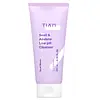What's inside
What's inside
 Key Ingredients
Key Ingredients

 Benefits
Benefits

 Concerns
Concerns

 Ingredients Side-by-side
Ingredients Side-by-side

Water
Skin ConditioningPEG-7 Glyceryl Cocoate
EmulsifyingDipropylene Glycol
HumectantGlycerin
HumectantSorbitol
HumectantButylene Glycol
HumectantPEG-10 Methyl Ether Dimethicone
EmulsifyingAmmonium Acryloyldimethyltaurate/Beheneth-25 Methacrylate Crosspolymer
Emulsion StabilisingCaprylyl Glycol
EmollientEthylhexylglycerin
Skin ConditioningChlorphenesin
AntimicrobialSodium Carbomer
Emulsion Stabilising1,2-Hexanediol
Skin ConditioningCitric Acid
BufferingDisodium EDTA
Sambucus Nigra Flower Extract
RefreshingSodium Hyaluronate
HumectantHyaluronic Acid
HumectantHydrolyzed Hyaluronic Acid
HumectantHydrolyzed Sodium Hyaluronate
Skin ConditioningHydroxypropyltrimonium Hyaluronate
Potassium Hyaluronate
Skin ConditioningSodium Hyaluronate Crosspolymer
HumectantPentylene Glycol
Skin ConditioningSodium Acetylated Hyaluronate
HumectantGlycyrrhiza Uralensis Root Extract
Skin ConditioningWater, PEG-7 Glyceryl Cocoate, Dipropylene Glycol, Glycerin, Sorbitol, Butylene Glycol, PEG-10 Methyl Ether Dimethicone, Ammonium Acryloyldimethyltaurate/Beheneth-25 Methacrylate Crosspolymer, Caprylyl Glycol, Ethylhexylglycerin, Chlorphenesin, Sodium Carbomer, 1,2-Hexanediol, Citric Acid, Disodium EDTA, Sambucus Nigra Flower Extract, Sodium Hyaluronate, Hyaluronic Acid, Hydrolyzed Hyaluronic Acid, Hydrolyzed Sodium Hyaluronate, Hydroxypropyltrimonium Hyaluronate, Potassium Hyaluronate, Sodium Hyaluronate Crosspolymer, Pentylene Glycol, Sodium Acetylated Hyaluronate, Glycyrrhiza Uralensis Root Extract
Water
Skin ConditioningCocamidopropyl Betaine
CleansingSodium Lauroyl Methyl Isethionate
CleansingSnail Secretion Filtrate
Skin ConditioningPolysorbate 60
EmulsifyingButylene Glycol
Humectant1,2-Hexanediol
Skin ConditioningAcrylates Copolymer
Tromethamine
BufferingEthyl Hexanediol
SolventSodium Polyacrylate
AbsorbentChamomilla Recutita Flower Oil
MaskingDipropylene Glycol
HumectantPanthenol
Skin ConditioningAllantoin
Skin ConditioningCitric Acid
BufferingPhenoxyethanol
PreservativeSodium Chloride
MaskingSodium Guaiazulene Sulfonate
Water, Cocamidopropyl Betaine, Sodium Lauroyl Methyl Isethionate, Snail Secretion Filtrate, Polysorbate 60, Butylene Glycol, 1,2-Hexanediol, Acrylates Copolymer, Tromethamine, Ethyl Hexanediol, Sodium Polyacrylate, Chamomilla Recutita Flower Oil, Dipropylene Glycol, Panthenol, Allantoin, Citric Acid, Phenoxyethanol, Sodium Chloride, Sodium Guaiazulene Sulfonate
 Reviews
Reviews

Ingredients Explained
These ingredients are found in both products.
Ingredients higher up in an ingredient list are typically present in a larger amount.
1,2-Hexanediol is a synthetic liquid and another multi-functional powerhouse.
It is a:
- Humectant, drawing moisture into the skin
- Emollient, helping to soften skin
- Solvent, dispersing and stabilizing formulas
- Preservative booster, enhancing the antimicrobial activity of other preservatives
Butylene Glycol (or BG) is used within cosmetic products for a few different reasons:
Overall, Butylene Glycol is a safe and well-rounded ingredient that works well with other ingredients.
Though this ingredient works well with most skin types, some people with sensitive skin may experience a reaction such as allergic rashes, closed comedones, or itchiness.
Learn more about Butylene GlycolCitric Acid is an alpha hydroxy acid (AHA) naturally found in citrus fruits like oranges, lemons, and limes.
Like other AHAs, citric acid can exfoliate skin by breaking down the bonds that hold dead skin cells together. This helps reveal smoother and brighter skin underneath.
However, this exfoliating effect only happens at high concentrations (20%) which can be hard to find in cosmetic products.
Due to this, citric acid is usually included in small amounts as a pH adjuster. This helps keep products slightly more acidic and compatible with skin's natural pH.
In skincare formulas, citric acid can:
While it can provide some skin benefits, research shows lactic acid and glycolic acid are generally more effective and less irritating exfoliants.
Most citric acid used in skincare today is made by fermenting sugars (usually from molasses). This synthetic version is identical to the natural citrus form but easier to stabilize and use in formulations.
Read more about some other popular AHA's here:
Learn more about Citric AcidDipropylene Glycol is a synthetically created humectant, stabilizer, and solvent.
This ingredient helps:
Dipropylene glycol is technically an alcohol, but it belongs to the glycol family (often considered part of the ‘good’ alcohols). This means it is hydrating and gentle on skin unlike drying solvent alcohols like denatured alcohol.
As a masking agent, Dipropylene Glycol can be used to cover the smell of other ingredients. However, it does not have a scent.
Studies show Dipropylene Glycol is considered safe to use in skincare.
Learn more about Dipropylene GlycolWater. It's the most common cosmetic ingredient of all. You'll usually see it at the top of ingredient lists, meaning that it makes up the largest part of the product.
So why is it so popular? Water most often acts as a solvent - this means that it helps dissolve other ingredients into the formulation.
You'll also recognize water as that liquid we all need to stay alive. If you see this, drink a glass of water. Stay hydrated!
Learn more about Water